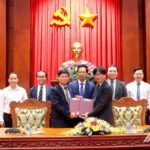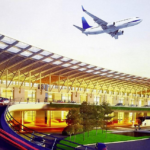According to statistics from the Ministry of Industry and Trade, while there were only about six logistics centers across Vietnam from 2007 to 2012, this number has increased tenfold in the past decade. A preliminary report from 45 out of 63 provinces and cities indicates that there are currently 69 logistics centers nationwide.
This rapid growth in the number of logistics centers signifies a shift towards developing large-scale, integrated facilities that serve specific industries or regions.
CHALLENGES IN LOGISTICS CENTER DEVELOPMENT
Logistics centers are no longer concentrated solely in the Southeast region, with the North and Central regions also witnessing the emergence of large-scale facilities such as the Bac Giang International Logistics Center and the Viettel Lang Son Logistics Park. Notably, these centers have embraced Industry 4.0 technologies and incorporated cold storage, bonded warehouses, and specialized facilities for agricultural produce, with stringent requirements for humidity control and ventilation systems.
However, at a seminar on “Developing Logistics Centers: Connecting and Unblocking Sustainable Supply Chains” held on May 29, Ms. Dang Hong Nhung, from the Import-Export Department of the Ministry of Industry and Trade, pointed out certain limitations in the development of these centers.
One key issue is the lack of formation of national-level logistics centers or even regional hubs that can drive the market and guide the country’s logistics planning.
Additionally, there are challenges in aligning the planning of transportation infrastructure with the development of logistics centers. Attracting investment and growing the network of logistics centers remain difficult tasks. While investing in logistics centers is included in the list of investment incentive sectors, the incentives offered are not specific enough and fall short of businesses’ expectations.
Moreover, not all enterprises recognize the benefits of outsourcing logistics services, making it challenging for logistics centers to find customers.

The current lack of specific regulations and policies regarding the development of logistics centers is also a concern. Although there have been orientations, there are no concrete definitions of what constitutes a logistics hub or clear criteria for classifying and ranking logistics centers.
From the perspective of a logistics center investor, Mr. Dao Van Thuahn, Deputy Director of Viettel Lang Son Logistics Park, highlighted the importance of data synchronization. Unifying data within the logistics center ecosystem and ensuring data consistency across different centers are crucial. Without this synchronization, optimizing costs and streamlining processes will remain challenging.
INTEGRATING LOGISTICS CENTER PLANNING WITH OVERALL DEVELOPMENT
To promote the growth of logistics centers, Mr. Hoang Dinh Kien, General Director of Hoa Phat Logistics Joint Stock Company, suggested that the government should issue regulations to support logistics centers in directly connecting with government agencies, companies, customers, brands, and logistics companies.
Ms. Truong Thi Mui, Deputy General Director of Bac Giang International Logistics Company Limited, emphasized the importance of government support alongside the efforts of investors and businesses. She suggested that legal corridors and institutional frameworks for logistics centers need to be concretized in policies to provide businesses with a more open environment and long-term investment orientation.
Additionally, while logistics centers have been planned and positioned within the national or local network, there is a need to integrate this planning with overall development. This includes considering multi-modal transportation connections, such as railways. As Ms. Mui pointed out, “A logistics center with access to a railway will have a different dynamic than one relying on multiple modes of transportation.”
Ms. Nhung agreed, emphasizing that in the future, logistics planning should be integrated into local planning and considered in relation to regional and national planning. Localities need to prioritize multi-modal infrastructure connectivity.
To attract investment in logistics centers, it is essential to improve the business environment and facilitate investors. Local authorities should provide substantial support in terms of administrative procedures, finance, and human resource training. In addition to central government policies, local authorities should also implement their own initiatives to attract investment in this sector.
Recognizing that businesses seek incentives, Ms. Nhung suggested that local governments take the lead in public-private partnership models for logistics center development. Localities can offer support in terms of planning, land clearance, and land use, while enterprises invest in warehouse operations and technology applications.
Furthermore, it is crucial to promote linkage and resource sharing, including physical infrastructure, information, and collaboration. This involves connecting logistics centers with enterprises and customers, fostering linkages between logistics centers, and even establishing links with government management agencies. By sharing information, customers, and routes, we can reduce waste in the logistics process and optimize our operations.
Avoiding the US Tariff Trap: The Urgent Need for Market Diversification in Textiles and Footwear
The diversification of the textile and footwear industry in the context of the US adjusting import taxes is an urgent issue. This was addressed at the Ministry of Industry and Trade’s conference on promoting trade with the Vietnamese trade offices abroad in May 2025.
“Provincial Land Prices are on the Rise: Investors Eye the Market”
The land plots priced at 30-35 million VND per square meter in the vicinity of Ho Chi Minh City, such as Can Giuoc, Duc Hoa, Ben Luc in Long An, and Long Thanh in Dong Nai, are becoming scarce. Compared to the same period last year, land prices have surged by 10-25%, depending on the lot and location. The primary supply entering the market is currently very limited.
The End of an Era: Bidding Farewell to Vinashinlines
The Hanoi People’s Court has declared Vinashin Ocean Shipping Joint Stock Company, or Vinashinlines, bankrupt as of May 5, 2025. This decision comes as a result of the company’s inability to recover from financial difficulties.
Unlocking Direct Flights: Sun Group’s Vision for Seamless Travel from Van Don to Seam Reap
“Quang Ninh Province is home to the magnificent Van Don International Airport, a groundbreaking venture that stands as Vietnam’s very first privately-owned airport project. This remarkable achievement is a testament to the vision and expertise of Sun Group, the driving force behind its development.”





















